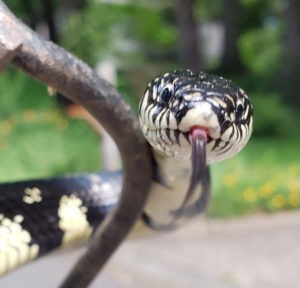Kings of the Urban Jungle
The transition from backwoods to backyards

By Samantha Kennett, Urban Kings Research Assistant and Previous CNC Wildlife Technician
When it comes to snakes, the National Wildlife Federation estimates at least 20% of the Georgia population carries a fear of snakes in some degree. If there is one snake species that people show a softer spot for, it is the harmless Eastern Kingsnake. Eastern Kingsnakes are Georgia native non-venomous snakes. Like many other snake species, Kingsnakes play a key role in managing rodent populations as your own natural form of pest control. But what Kingsnakes are really known for, and the reason they are called the “king,” is their ability and proclivity to prey on venomous snakes like rattlesnakes and copperheads. Though anything with a mouth can bite, Kingsnakes are general docile snakes not known to bite often.
Despite living in a wide range of areas across the Eastern United States, the Eastern Kingsnake has been going through a noticeable decline in population within the Florida and South Georgia areas of their range. According to the Savannah River Ecology Laboratory, one of the largest populations along their Savannah River site has almost entirely disappeared over the span of 20 years. However, this is not the case in the Metro-Atlanta area where Kingsnakes are spotted frequently and seem to be doing relatively well. It’s exciting to think that these snakes seem to have some survivability in urban environments, but what do these snakes need to survive? How much space do they need? What habitats within an urban setting are they utilizing? What might be limiting their survival? In future urban planning and development, how can we better coexist with wildlife and create livable habitats where they will not only survive, but thrive? These are just a few of the questions the Urban Kings Project is trying to answer.

In 2019, the Urban Kings Project, a citizen science endeavor, began working to understand just how these urban Kingsnakes seem to do so well in developed and developing urban landscapes. This research is focused on understanding how different levels of urban development are influencing Eastern Kingsnake movements, habitat use, health, and overall survival. Part of the goal is to create an evidence-based strategy to help future urban developers and planners create effective green space where wildlife can remain in areas with lots of people. To better understand how populations are changing over time, the researchers are creating a population distribution database filled with Kingsnake sightings reported by citizen scientists.
Being a citizen science project, there is a lot of community involvement. Though this project focuses on the survival and study of these incredible snakes, education and public outreach is another goal. Whether it’s working public community outreach programs or responding to Kingsnake house calls, the people behind this project work diligently to help community members understand the importance of Kingsnakes in their neighborhood. These outreach opportunities are pursued to encourage people to participate in reporting sightings, but also in hopes to alleviate some of those snake fears.

This project would not be possible without the continued support of community citizen scientists, and YOU can be one of them! To participate, please keep an eye out for your neighborhood Kingsnakes. If you see one:
- Please call the Urban Kings Project immediately (Bryan Hudson 404-556-1863 or Samantha Kennett 678-315-2020). They need to examine the snakes to collect certain data, such as sex, weight, length, health screens, and to obtain a non-invasive DNA sample (clip a few belly scales, essentially the same thing as cutting your fingernails).
- Keep an eye on the snake if possible until you have reached them on the phone.
- Try to take a quick picture on your phone without disturbing the snake (trying to keep them from escaping before someone can respond).
- And if you find a dead Kingsnake (road kill, cat/ dog kill, etc.) PLEASE collect the specimen by placing it in a few plastic bags. They can still gather lots of important data from these animals, so they do not go to waste! If you can’t collect the dead snake, please call the project immediately and they will try to get out to collect it before it disappears.
If you’re lucky enough to have a larger neighborhood Kingsnake, your snake might be a part of the movement aspect of the study. If the Kingsnake is a large enough individual, the partner team of veterinarians at the UGA veterinary school will implant a tiny radio transmitter just under the skin. This is a quick and easy procedure. The Kingsnake will then be released in the exact spot that it was found. This allows the researchers to follow the animal, which tells them what helps them survive in urban environments. This is the fun part, and the part that you can come out and observe.
We live in a time where it seems a new neighborhood is developing on every corner. As urban landscapes continue to expand, our choices in how to create them are more important than ever in how these actions will impact the world around us. Projects like this one help us take a step in the right direction for choices that support human-wildlife coexistence. For more information regarding the Urban Kings project or to report your Kingsnake sightings, please check out the project page here.

